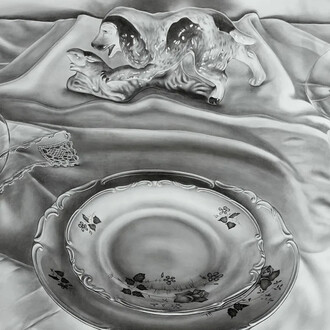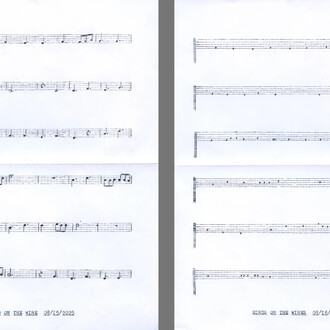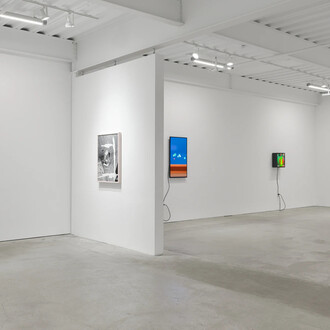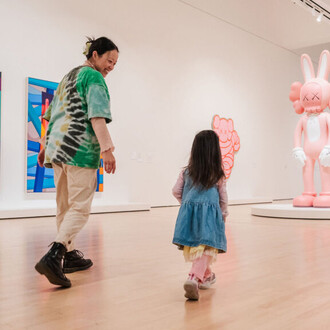Catharine Clark Gallery opens its Summer 2024 program with three exhibitions: Listening chamber, a solo exhibition by Amy Trachtenberg, in the North Gallery; The sky you were born under: sharing stories through abstraction, a group exhibition featuring work by Ashwini Bhat, Chelsea Bighorn, Dorothy Napangardi, Esteban Ramón Pérez, Sara Siestreem (Hanis Coos), Carlos Villa, and Marie Watt, in the South Gallery; and The gardens of Maladies, a video animation by Zeina Barakeh, in the Media Room.
Amy Trachtenberg combines found or reclaimed materials with more traditional art-making mediums, such as linen (previously owned by Sam Francis), oil paint, or inks. She is drawn to the tensions and unexpected harmonies that emerge when seemingly unlike materials are layered upon one another. Trachtenberg cites interdisciplinary artist and Black Mountain College co-founder Anni Albers (1899 – 1994) as an inspiration, particularly Albers’s maxim that artists are most successful when they “listen” to their materials and allow themselves to be intuitively guided by them. In her influential 1982 essay “Material as Metaphor,” Albers posited: “How do we choose our specific material, our means of communication? Accidentally. Something speaks to us—a sound, a touch, hardness or softness, it catches us and asks us to be formed. I learned to listen to [my materials] and to speak their language. I learned the process of handling them”.
In her exhibition Listening chamber, Trachtenberg handles her materials expansively: she dissects and wraps objects, stitches bras into hanging nets, photocopies, tears and collages newspapers, casts found branches in bronze, creases canvas, manipulates bicycle tire tubing, and creates relief prints from garments pressed into canvas with an etching press. In several of the paintings, Trachtenberg folds raw linen canvases into peaks and crests. The large canvas and linen work titled At dusk we go down to the river because it shows us the way to the sea is coated in an aluminum-based paint, apart from where the folds are that collectively suggest a delta. The painting has a metallic luster that simultaneously evokes bodies of water and architectural or geological forms. Trachtenberg writes that “in these paintings, I wanted to experiment with how to draw with folds instead of brushes. By manipulating my canvases and giving them dimensionality and structure, I release them from a frame and evoke a dialogue with my sculptural works”.
Similarly, Trachtenberg describes her etching press works as “an extension of my collage practice, which comes out of my impulse to collect evidence from the world around us. In these relief prints, I am interested in how the resulting images resemble negatives and x-rays in that they both reveal and obscure the original objects that are run through the press onto the canvas. I add layers of pastel and colored pencil to further draw out the light and shadows so these ‘traces’ have an almost otherworldly aura. This aura is meant to evoke how objects are never simply dormant but always have an active relationship with one another”. This is particularly evident when a work such as Saudade, made from found, crushed aluminum and neon paint, glows against the wall calling our attention to a similarly colored wound-like mark in the center of an adjacent, large scale, acrylic, oil stick, and color pencil painting titled Twice promised.
Listening chamber also includes collage-based works that draw on several decades of reportage of wars and displacement. To create these collaged compositions, Trachtenberg photocopies newspapers and printed reportage, altering these images by folding and overlaying them so that the original images become increasingly distorted and abstract. Though the images are not always immediately legible, closer inspection reveals key details: a line of text from the New York Times, or the shroud of an older woman seated on the ground. Trachtenberg writes that “the images in these collages draw upon patterned textiles, landscapes, images of hands and eyes, and depictions of vulnerable people. The collages reflect on this continued feeling of grief, both globally and closer to home”. These works evoke the feeling of being constantly unsettled and overwhelmed by war and global conflict. In reflecting on this, Trachtenberg asks us to pause and to reflect: to spend careful time with those reports and images of war that quickly pass us by, and to think about and connect with the human stories that are lost in that noise. It bears mentioning that the collages were created prior to the events of October 7, 2023, and the war that followed.
In conjunction with Trachtenberg’s exhibition, the gallery presents The sky you were born under: sharing stories through abstraction, a group exhibition in the South Gallery. Inspired by U.S. Poet Laureate Joy Harjo's poem Remembering (1983), The sky you were born under features works by seven artists who, like Trachtenberg, use abstraction as a storytelling tool. The artists – Ashwini Bhat, Chelsea Bighorn, Dorothy Napangardi, Esteban Ramón Pérez, Sara Siestreem (Hanis Coos), Carlos Villa, and Marie Watt – delve into themes centered on ecologies, genealogies, colonialism, and Indigenous futures.
The exhibition includes three new ceramics by Ashwini Bhat, which expand on the ideas in her featured presentation in BAN9: Bay Area Now at Yerba Buena Center for the Arts. Bhat's interdisciplinary practice reflects an interest in ecology, place, and a metaphysical understanding of nature and self. Her new sculpture series, "Circumambulation of Mt. Tamalpais" (2024), builds on earlier work that responds to the topography of Marin County and her quest for belonging as an immigrant to the United States. Bhat explains that “Circumambulation is a ritual of moving around a sacred object, a ceremonial practice in Hinduism and Buddhism. Since 2020, my partner, the poet and writer Forrest Gander, and I have circumambulated Mt. Tamalpais, retracing the steps of poets Gary Snyder, Allen Ginsberg, and Philip Whalen, who completed their own clockwise hike around the mountain in 1965 as a ritual meditation".
Bhat draws references from calla lilies in her Northern California garden in Penngrove to Yakshis, pre-Aryan animistic nature spirits from India. Depicted as half woman and half plant, Bhat’s sculptures metaphorically relate to Yakshis who return as spirits to avenge their deaths across Hindu, Buddhist, and Jain practices. Resembling human bodies or tree limbs, the biomorphic forms bear blaze marks as trail markers, symbolic of regeneration from wildfire or forest regrowth. These works incorporate thread, used in India to designate sacred objects, and include symbols like calla lilies, thistles, and deer antlers, representing regeneration. Bhat’s work is presented in partnership with Shoshana Wayne Gallery.
The exhibition also showcases works by Los Angeles-based artist Esteban Ramón Pérez, whose work was recently in Made in L.A. 2023: acts of living at the Hammer Museum, curated by Diana Nawi and Pablo José Ramírez. Ramón Pérez’s practice, informed by his background as a professional upholsterer, interweaves his Chicano heritage with postmodern visual language and issues of postcolonial history. The exhibition highlights Ramón Pérez’s painting Star spangled (2019) and pieces from the series Falling stars. According to Marissa del Toro, independent curator and Assistant Director at NXTHVN, where Pérez was a fellow, “Ramón Pérez uses remnants of an American flag and upholstery materials to construct abstract narratives, exploring personal and cultural symbolism. The American flag is one of the most widely recognizable symbols globally and is ubiquitous with Americanism or American patriotism. Ramón Pérez questions and references the complications of Americanism and offers the cultural codes and signifiers from his subjectivity and distinct material choices as a response. He uses remnants of the heavily infused patriotic emblem of the flag to deface and reconstruct the object and its symbolism into a patchwork composition of disjointed and fragmented scenes that perhaps alludes to the socio-political reality of 2019 in the United States, where impeachment and immigration were pervasive issues”.
Another significant work in the exhibition is Carlos Villa’s Waikiki (little wave) (1972). Villa (1936-2013), a San Francisco-born visual artist and educator, challenged colonial perspectives through his eclectic practice that drew from cultures worldwide. Curators Trisha Lagaso Goldberg, Mark Dean Johnson, and Sherwin Rio note that “Carlos Villa’s works of the 1970s are among the most visually exuberant and widely exhibited of his career. These reflect the artist’s eclectic inspirations, drawn largely from non-western sources, including specific ethnographic objects from the Philippines, Papua New Guinea, Hawaii, New Zealand, Australia, and Africa. Having gained notoriety for his work with feathers, he explained, ‘I use feathers because they breakup an area in a certain kind of way. I like the way the feathers feel to me visually. Because when I look at my work, I like to touch my work with my eyes. And so, there’s just something about the visual chemistry of what a feather does – or what feathers do – to a certain kind of surface”.
Villa’s Waikiki (little wave) is one of his last remaining “cape works.” Originally molded on his body, it is based on the life cycle of a tropical forest. Villa spread feathers, nails, shards of glass, and blood across the painted green canvas, suggesting both the tensions between (possibly violent) manmade interventions and a powerful subsuming environment. Villa’s work is presented in collaboration with Paul Thiebaud Gallery. You can learn more about all the exhibiting artists by visiting our website.
In the gallery’s Media Room is a presentation of The gardens of Maladies (2021 – 2024) by affiliated artist Zeina Barakeh. Barakeh’s animation, which meanders between abstraction and representation, explores themes of mental and physical illness and human enhancement, referencing Hieronymus Bosch’s The garden of earthly delights (1490 – 1510). A recent recipient of an Artadia Award (2024) and a three-person exhibition at the Schneider Museum—What’s at stake – Barakeh’s screening is the second time her work has been exhibited at Catharine Clark Gallery. In the announcement about the Artadia award, Lauren Harvey for the SF Chronicle writes: “Drawing upon her experiences in Lebanon [Barakeh grew up in Beirut and moved to the Bay Area in 2006], Barakeh focuses on the complexities of war. In her research and art, she addresses emerging military technologies, human enhancement and, most recently, cyber warfare. ‘I would describe my work as very intricate, very heavy on research, very layered. Everything is very deliberate, because I try to have some agency in the process of my own work,” she said. “This is something that I can actually control”. In EXiT, the gallery presents sculptural jewelry and works on paper by Tina Rath, which are an extension of ideas such as loss and compassion considered in her Requiem Project. The works on paper are from a series titled Order of beauty, that are based in geometric patterns derived from the Breath of the compassionate, which in Islamic tradition is an eight-pointed star, also significant to many cultures and religions. The drawing of gold patterns contained within circles suggests the infinite and expansive universe. The gold in Rath’s work is refined into powder and used as paint. It is a material employed in most spiritual traditions, synonymous with divine power. The Lapis lazuli, a semi-precious stone ground, is transformed into a painting paste, and used in the drawings. The color--a celestial blue--is associated with the divine, wisdom, and truth. It is believed to bring inner peace. The sculptural jewelry employs repeated, circular and radial forms, also referencing the Sanskrit work Dharana, meaning “holding steady,” concentration, and “single focus”.
The purpose of the repetition is to soothe the distracted mind. As an extension of her practice, Rath presents Requiem, an EXiT and Boxblur produced communal event held on August 24, inviting participants to engage in a Compassion drawing— a collective exercise of creating circles to reflect on individual loss and the collective grief experienced by the world over since 2020. Requiem was originally presented at Grace Cathedral. Conceived as a memorial, the project consisted of large-scale circles drawn in golden ink on paper. One circle = one person who died from COVID-19. Rather describes how “each person’s circles are like fingerprints and the names included within the circles are often embellished with hearts, nicknames and ornamentation. The finished drawings are tapestries that express the collective, diverse and inclusive nature of The Requiem Project and experience of mourning”.
The gallery acknowledges the support of Crown Point Press, Elizabeth Leach Gallery, PDX Contemporary, Paul Thiebaud Gallery, and Shoshana Wayne Gallery in presenting works by Dorothy Napangardi, Sara Siestreem (Hanis Coos), Marie Watt, Carlos Villa, and Ashwini Bhat, respectively.
















